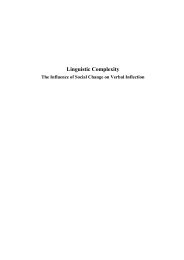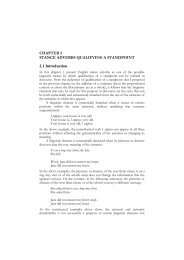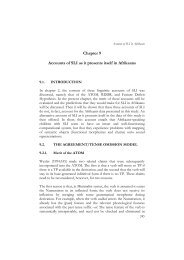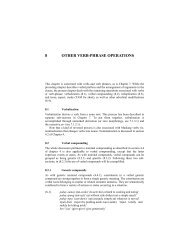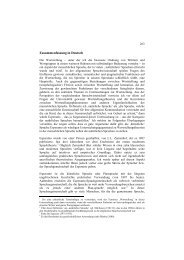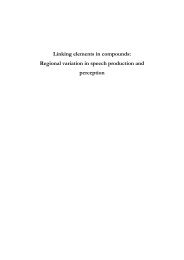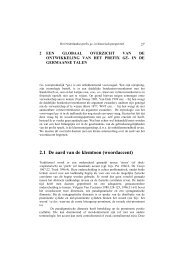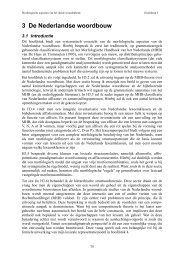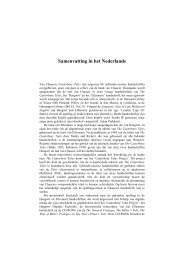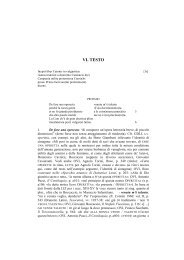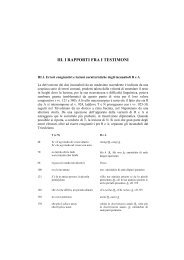Chapter 3 The Dutch Situation - LOT publications
Chapter 3 The Dutch Situation - LOT publications
Chapter 3 The Dutch Situation - LOT publications
Create successful ePaper yourself
Turn your PDF publications into a flip-book with our unique Google optimized e-Paper software.
<strong>The</strong> <strong>Dutch</strong> <strong>Situation</strong><br />
their gender. Gender affiliation was established on the basis of the usage by the<br />
honoured writers Pieter Corneliszoon Hooft (1581-1647) and Joost van den Vondel<br />
(1587-1679). 6 This list was reprinted and updated by various other scholars (see<br />
Rutten 2006 for the history of the word list). As time proceeded and the written and<br />
the spoken gender system drifted further apart, the matter moved from a<br />
grammatical to an orthographic issue and was mainly discussed in the context of<br />
spelling reforms. Notorious for its gender and case normativity is the orthography by<br />
De Vries en Te Winkel (1863) and their Woordenlijst voor de spelling der<br />
Nederlandsche taal (1866), the forerunner of what is now Het Groene Boekje ‘the<br />
green booklet’. Issued by the Nederlandse Taalunie (<strong>Dutch</strong> Language Union) under<br />
the name of “Woordenlijst Nederlandse Taal”, this book represents the official<br />
spelling dictionary, and is probably the most widely consulted source on<br />
grammatical gender.<br />
<strong>The</strong> last of the inflectional suffixes on determiners and adjectives, the masculine -n,<br />
was declared optional by the orthography of Marchant (1947) and later by the<br />
Groene Boekje of 1954, “waarna er nooit meer iets van is vernomen” (“whereupon<br />
nothing more was heard of it”, Van der Sijs 2004: 445, author’s translation). <strong>The</strong><br />
<strong>Dutch</strong> authorities finally embraced the system that had prevailed in the spoken<br />
standard language all along. Adjectives and articles now take the forms as in (3),<br />
both in the nominative and the oblique case (no case distinctions productively exist<br />
in present day <strong>Dutch</strong> outside the paradigms of the personal pronouns, except for a<br />
genitive-s which is restricted to proper names and terms of address such as vader<br />
‘father’). 7<br />
(3) de oud-e man een oud-e man<br />
DEF.C old-C/N man(C) an old-C man(C)<br />
de jong-e vrouw een jong-e vrouw<br />
DEF.C young-C/N woman(C) a young-C woman(C)<br />
het klein-e kind een klein kind<br />
DEF.N small-N child(N) a small.N child(N)<br />
As regards adnominal elements, <strong>Dutch</strong> no longer distinguishes masculine and<br />
feminine gender. From a linguistic point of view, this means that the two genders<br />
have merged into one. <strong>The</strong> group that combines the original masculines and<br />
6 Unfortunately, even the role models for gender usage proved to be unreliable.<br />
Vondel, born to Brabantian parents in German Cologne, differed quite often in his<br />
gender choice from Hooft, who was born and raised in Amsterdam. Besides, neither<br />
of the authors was fully consistent in his own work (see Kollewijn 1916 for<br />
comparison and critical discussion).<br />
7 Unproductive remnants of inflected forms are preserved in fixed expressions such<br />
as de tand des tijds ‘time's tooth’, ter wereld ‘of/in(to) the world’, in koelen bloede<br />
‘in cold blood’.<br />
38



